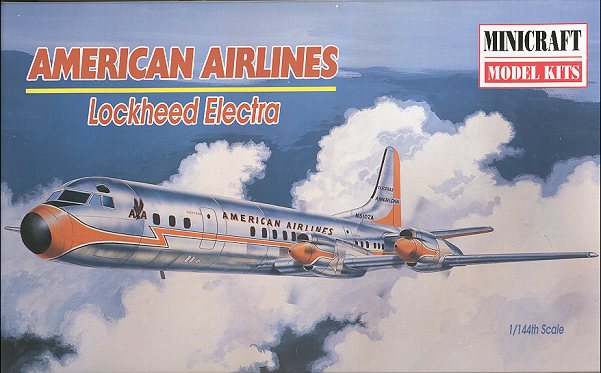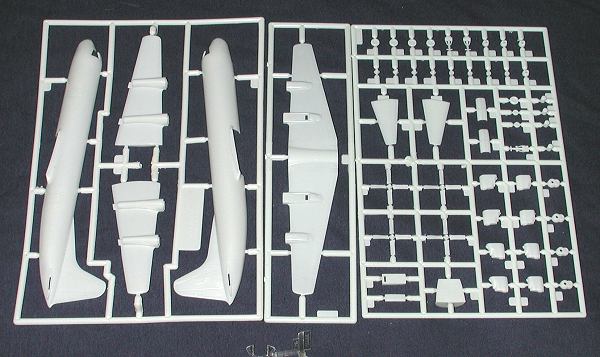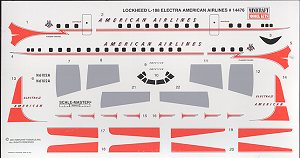
|
KIT: |
Minicraft 1/144 L-188 Electra |
|
KIT # |
14476 |
|
PRICE: |
$12.98 |
|
DECALS: |
American Airlines |
|
REVIEWER: |
|
|
NOTES: |

|
HISTORY |
One thing about airliners that many do not realize, is that often their design is commissioned by the requirements of an airline. Well, I guess I should say that it was the way airliner design was initiated. I guess that today's planes are more done by a perceived need than any specific airline requirements. Well the Lockheed L-188 Electra was developed because American Airlines wanted a plane to operate on the mid and short haul routes. While jets were fine for longer distances, they were not economical to operate on the shorter runs.
You also have to realize that this was the early 1950s and that even jet airliners were few and far between. However airlines saw the writing on the wall and knew that the turbine engine was the way of the future. British aviation was at the forefront of turbine technology and it was the Vickers Viscount that proved the viability of the turboprop to combine near jet speed and near piston fuel economy. It convinced American Airlines that they should have some of these turboprop aircraft.
Previously, Lockheed had been approached for such an aircraft, but the designs offered just were not appealing enough. American wanted a 75 passenger, 2,000 mile range aircraft, but no one else was interested. By increasing the capacity to 85-90 passengers and putting in more powerful engines as were being used on the new C-130 transport, Eastern also became interested. American ordered 35 and Eastern 40 aircraft in mid 1955.
The prototype first flew in late 1957 and entered service in mid 1959. Eventually well over a hundred Electras were sold to various airlines. By the mid 1960s, the Boeing 727 was available and took over the same routes that were served by Electras. They quickly disappeared from US passenger service and found new life in overseas markets or converted to freighters.
While few are still in the skies, its legacy lives on in the P-3 Orion, a plane that was derived from the Electra.
|
THE KIT |

As with a large number of models today, this one is made in China. Upon opening the nice, sturdy box, one is greeted by a sea of white styrene. The kit is packaged with no more than two sprues per bag which helps to prevent the scratching of the plastic so often found in Hasegawa kits. Detailing is engraved and well done. There are no windows molded into the fuselage; these being represented by decals. In terms of being able to use the same basic mold for many different boxings, this is the way to do things. It also makes using aftermarket decals easier. I know there is a segment of the airliner building population that doesn't like this, but it seems that more and more airliner models are molded this way.
I found no problems with flash, sink marks or ejector pin marks, though I'll confess it is tough to see these things in white plastic. While the sprue attachment points are properly small, there is little room to cut some of the smaller pieces so I'd recommend using a razor saw to remove parts. Be particularly careful of the props as their attachment points to the hubs are very thin and may easily break. Gear doors are molded as one piece so will have to be cut apart to display the plane on the ground. If there ever was a category of kits that should have a stand, it is airliners, I don't know about you, but to me they just look nicer on a stand than sitting on landing gear.
 Instructions are pretty basic,
but really don't need to be too fancy. One thing that is interesting is that
there is a cockpit, but only the floor and bulkhead. No seats or anything else
in there. Frankly since you are probably going to put a decal over the cockpit
windows, I wonder why there is even a clear part included in the kit.
Decals are from Cartograf in Italy and are very nicely printed. They are for the
nice orange lightning bolt scheme over natural metal. A nice touch is the
inclusion of the corroguard upper wing areas. As with all airliner decals,
getting the nose part to mold properly may be a mot of a challenge.
Instructions are pretty basic,
but really don't need to be too fancy. One thing that is interesting is that
there is a cockpit, but only the floor and bulkhead. No seats or anything else
in there. Frankly since you are probably going to put a decal over the cockpit
windows, I wonder why there is even a clear part included in the kit.
Decals are from Cartograf in Italy and are very nicely printed. They are for the
nice orange lightning bolt scheme over natural metal. A nice touch is the
inclusion of the corroguard upper wing areas. As with all airliner decals,
getting the nose part to mold properly may be a mot of a challenge.
|
CONCLUSIONS |
Airliner enthusiasts should be quite pleased with the state of airliner modeling today. Thanks largely to Minicraft, there are models of types available in 1/144 that could only be dreamed about a few years ago. Aftermarket decal people have been quick to take advantage of that to produce some very nice sheets for these planes. It looks as if it will be a nice build and has to be easier than all the work required to convert the LS P-3 Orion kit!!
If you would like your product reviewed fairly and quickly where it will be seen by well over 150,000 visitors a month, please contact me or see other details in the Note to Contributors.